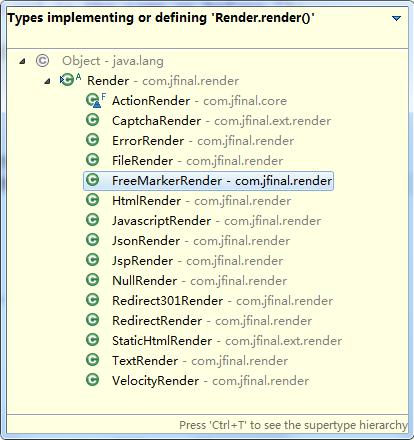①从web.xml文件中可以看出jfinal框架本质上是一个Filter
<!DOCTYPE web-app PUBLIC
"-//Sun Microsystems, Inc.//DTD Web Application 2.3//EN"
"http://java.sun.com/dtd/web-app_2_3.dtd" >
<web-app>
<display-name>jfinal</display-name>
<filter>
<filter-name>jfinal</filter-name>
<filter-class>com.jfinal.core.JFinalFilter</filter-class>
<init-param>
<param-name>configClass</param-name>
<param-value>com.demo.config.DemoConfig</param-value>
</init-param>
</filter>
<filter-mapping>
<filter-name>jfinal</filter-name>
<url-pattern>/*</url-pattern>
</filter-mapping>
<welcome-file-list>
<welcome-file>index.html</welcome-file>
</welcome-file-list>
</web-app>
②JFinalFilter重写了doFilter方法,所有的处理都在该方法中完成
public void doFilter(ServletRequest req, ServletResponse res, FilterChain chain) throws IOException, ServletException {
HttpServletRequest request = (HttpServletRequest)req;
HttpServletResponse response = (HttpServletResponse)res;
request.setCharacterEncoding(encoding);
String target = request.getRequestURI();
if (contextPathLength != 0)
target = target.substring(contextPathLength);
boolean[] isHandled = {false};
try {
handler.handle(target, request, response, isHandled);
}
catch (Exception e) {
if (log.isErrorEnabled()) {
String qs = request.getQueryString();
log.error(qs == null ? target : target + "?" + qs, e);
}
}
if (isHandled[0] == false)
chain.doFilter(request, response);
}
Handler的实现类

③Hander接口有多个实现类,我们分析ActionHandler的handler()方法
/**
* handle
* 1: Action action = actionMapping.getAction(target)
* 2: new ActionInvocation(...).invoke()
* 3: render(...)
*/
public final void handle(String target, HttpServletRequest request, HttpServletResponse response, boolean[] isHandled) {
if (target.indexOf(".") != -1) {
return ;
}
isHandled[0] = true;
String[] urlPara = {null};
Action action = actionMapping.getAction(target, urlPara); //根据ActionMapping中的映射获取处理当前请求的Action
if (action == null) {
if (log.isWarnEnabled()) {
String qs = request.getQueryString();
log.warn("404 Action Not Found: " + (qs == null ? target : target + "?" + qs));
}
renderFactory.getErrorRender(404).setContext(request, response).render();
return ;
}
try {
Controller controller = action.getControllerClass().newInstance(); //实例化Controller处理类
controller.init(request, response, urlPara[0]); //初始化Controller
if (devMode) {
boolean isMultipartRequest = ActionReporter.reportCommonRequest(controller, action);
new ActionInvocation(action, controller).invoke();
if (isMultipartRequest) ActionReporter.reportMultipartRequest(controller, action);
}
else {
new ActionInvocation(action, controller).invoke(); //调用Controller中相应的处理方法(详见)
}
Render render = controller.getRender(); //根据Controller中的设置获取数据和视图的对应类Render
if (render instanceof ActionRender) { //如果render是一个ActionRender,则再交给对应的Handler处理
String actionUrl = ((ActionRender)render).getActionUrl();
if (target.equals(actionUrl))
throw new RuntimeException("The forward action url is the same as before.");
else
handle(actionUrl, request, response, isHandled);
return ;
}
if (render == null) //如果render,则使用默认Render
render = renderFactory.getDefaultRender(action.getViewPath() + action.getMethodName());
render.setContext(request, response, action.getViewPath()).render(); //调用Render实现类的render()方法进行渲染
}
catch (RenderException e) {
if (log.isErrorEnabled()) {
String qs = request.getQueryString();
log.error(qs == null ? target : target + "?" + qs, e);
}
}
catch (ActionException e) {
Render的实现类

④在ActionInvocation的invoke()方法中,请求先经过一系列拦截器
/**
* Invoke the action.
*/
public void invoke() {
if (index < inters.length)
inters[index++].intercept(this);
else if (index++ == inters.length) // index++ ensure invoke action only one time
// try {action.getMethod().invoke(controller, NULL_ARGS);} catch (Exception e) {throw new RuntimeException(e);}
try {
action.getMethod().invoke(controller, NULL_ARGS);
}
catch (InvocationTargetException e) {
Throwable cause = e.getTargetException();
if (cause instanceof RuntimeException)
throw (RuntimeException)cause;
throw new RuntimeException(e);
}
catch (RuntimeException e) {
throw e;
}
catch (Exception e) {
throw new RuntimeException(e);
}
}





 本文介绍了JFinal框架的工作原理,从web.xml配置入手,详细解析了JFinalFilter如何作为过滤器处理HTTP请求,ActionHandler如何根据URL映射找到并执行相应的Controller方法,以及ActionInvocation如何通过拦截器链调用具体的业务逻辑。
本文介绍了JFinal框架的工作原理,从web.xml配置入手,详细解析了JFinalFilter如何作为过滤器处理HTTP请求,ActionHandler如何根据URL映射找到并执行相应的Controller方法,以及ActionInvocation如何通过拦截器链调用具体的业务逻辑。
















 770
770

 被折叠的 条评论
为什么被折叠?
被折叠的 条评论
为什么被折叠?








